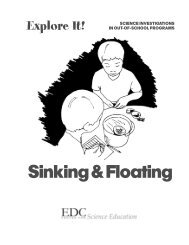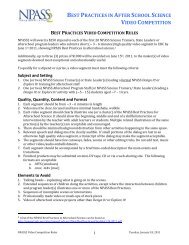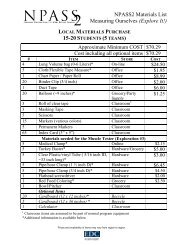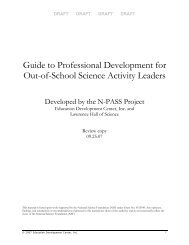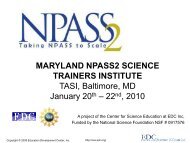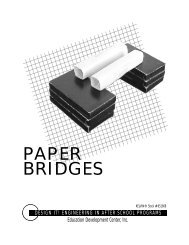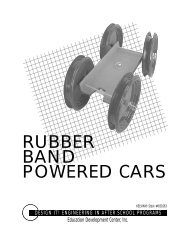Winter 2007 - NPASS2
Winter 2007 - NPASS2
Winter 2007 - NPASS2
- No tags were found...
You also want an ePaper? Increase the reach of your titles
YUMPU automatically turns print PDFs into web optimized ePapers that Google loves.
Annenberg Institute for School Reform | Voices in Urban Education<strong>Winter</strong> <strong>2007</strong>TowardProficiencyIntellective CompetenceEdmund W. GordonAcademic Proficiency:Bright Hopes, Blurry VisionLauren B. Resnick and Lindsay Clare MatsumuraIntegrating Text in Content-Area Classes:Better Supports for Teachers and StudentsLouis Gomez, Phillip Herman,and Kimberley GomezThe Investigators Club:An Alternative to Textbook ScienceRichard Sohmer and Sarah MichaelsBeyond the Classroom:Collective Responsibility for DevelopingProficiency in Urban YouthRhonda H. Lauer
Beyond the Classroom: Collective Responsibilityfor Developing Proficiency in Urban YouthRhonda H. LauerProficiency includes more than academic abilities, and achieving it will require supportfrom out-of-school institutions as well as schools.Rhonda H. Lauer ischief executive officerof Foundations Inc.Most states define proficiencyin specific terms. In Pennsylvania, forinstance, students perform at a proficientlevel if their standardized-test scoresreflect satisfactory academic performance.They cannot earn high schooldiplomas without demonstrating proficiencyin reading and mathematics,either through their state test scoresor in other ways determined by theirschool districts.But shouldn’t proficiency entailmore than meeting explicitly definedreading and mathematics standards?Achieving proficiency in basicacademic skills must still be a goal forall students, particularly for urban,lower-income students who face significantchallenges: unsafe schools, lowperformance expectations, and limitedresources. A first step in reviving theseschools must be to remove such obstaclesto learning.At the same time, we must realizethat academic proficiency is only oneelement in a set of skills young peoplerequire to become self-sufficient adults.Our definition of proficiency shouldbe more expansive, implying a levelof skill and knowledge beyond specificcontent areas; it must encompasspractical “life skills” such as teamwork,creative thinking, professionalism,self-advocacy, and readiness for workor college.When discussing proficiency, wealso need to look outside the contextof school and redefine the learningday. Children encounter many criticaltransitions in their lives, from birthinto adulthood; to advance, they mustacquire certain skills, knowledge, andbehaviors. And yet, they spend just 20percent of their waking hours in school(Corporate Voices for Working Families2004). Clearly, learning cannot be anactivity that occurs only inside a schoolbuilding. After school, weekends, athome, with parents, in the community– these are all times and places forchildren to learn and grow.This article addresses some ofthe challenges to building academicproficiency in urban youth and presentsworkable solutions. It also proposes abroader definition of proficiency, onethat encompasses essential life skills aswell as basic reading and mathematicsskills. And finally, it provides examples42 Annenberg Institute for School Reform
of initiatives that move beyond theclassroom and rely on long-term commitmentsand strategic partnershipsto help children develop proficiency atevery stage of life.Addressing Obstaclesto Academic ProficiencySince 2002, Foundations’ NeighborhoodSchool Network (NSN) has managedseveral inner city schools for theSchool District of Philadelphia. 1 Priorto our involvement, these six schools –three elementary schools, two middleschools, and one high school – faceddaunting challenges. The high school,Martin Luther King High School(MLKHS), was perceived as a schoolof last resort, where academics weresecondary to safety concerns.Creating an atmosphere conduciveto learning was the first step in improvingacademic achievement at theseschools. At MLKHS, this has meant:• moving youth out of the hallwaysand into the classrooms, creatinga safe environment, improving theappearance and resources of theschool, implementing a dress code,and providing leadership developmentfor administrators;• equipping teachers with the toolsthey need to provide meaningfulinstruction, including new textbooks,access to technology, professionaldevelopment, content-area coaching,and administrative support;1 On December 22, 2001, the state ofPennsylvania took control of the School Districtof Philadelphia. For years, the district struggledwith failing schools and substantial deficits. Toreverse this trend, several for-profit and nonprofitorganizations were selected to assume managementof some of the city’s lowest-performingschools. Foundations manages Robert FultonElementary School, John Kinsey Elementary School,Francis Pastorius Elementary School, Ada LewisMiddle School, and Clarence Pickett MiddleSchool. Martin Luther King High School wasadded to the NSN in 2003.• encouraging the community tobecome invested in the school’ssuccess through the developmentof a parent association, volunteeropportunities, and local youthemployment initiatives;• offering students the assistancethey need to acquire necessaryacademic and life skills, includingAdvanced Placement courses,after-school homework assistance,meaningful extracurricular activities,and summer school opportunities.V . U . E . <strong>Winter</strong> <strong>2007</strong> 43
Life skills are essential for young peopleto succeed. Organizations today arenot seeking workers who are merelyproficient in reading and mathematics.As a result of these types of efforts,students at MLKHS and throughout theNSN are making progress. More NSNstudents are performing at advanced andproficient levels in reading and mathematics,as defined by the state. NSNschools are keeping pace with or exceedingthe performance of comparableschools managed by the School Districtof Philadelphia or other private managers.And more students, at all levels,are scoring at or above the nationalaverage in reading, language, and mathematicson Terra Nova tests.Equipping Youth withEssential Life SkillsAsserting control over school cultureand instruction has allowed us toimprove students’ academic skills atthese schools. It also has permitted usto offer programs and services that helpstudents become proficient in otheressential life skills.We are addressing these skillsbecause we know that they are essentialfor young people to succeed afterhigh school. Organizations today arenot seeking workers who are merelyproficient in reading and mathematics.A recent survey of more than four hundredemployers indicates that, althoughbasic academic content is still fundamentalto new workforce entrants’ability to perform, some of the mostimportant skills they need to succeedin the workplace are “soft skills,”including:• professionalism/work ethic;• oral and written communications;• teamwork/collaboration; and• critical thinking/problem solving(Casner-Lotto & Barrington 2006)Admittedly, the primary goal ofeducation is not to train workers; butsooner or later, most youth enter theworkforce. Only 60 percent of lowincomeyouth in this country can expectto earn a high school diploma, the basiccredential for entry-level employmenttoday. One in three can expect to enrollin college. Only one in seven will earna bachelor’s degree (Bedsworth, Colby& Doctor 2006). Students who do notplan to enter college must be able tofind jobs after high school.At MLKHS, the Job Resource andDevelopment Center (JRDC) 2 teachesessential life skills so young people canthrive no matter what they do afterhigh school – attend college, enter thearmed services, or seek employment.The JRDC helps youth acquire five competenciesdeemed essential to masteringthe demands of the modern workplace– the ability to: identify, organize, plan,and allocate resources; work with others;acquire and use information; understandcomplex interrelationships; and2 The JRDC is a collaborative initiative,conceived and developed by Pennsylvania StateRepresentative Dwight Evans, the GreaterPhiladelphia Urban Affairs Coalition, the SchoolDistrict of Philadelphia, and Foundations.44 Annenberg Institute for School Reform
work with a variety of technologies(U.S. Dept. of Labor 1991).Housed at MLKHS, the JRDCexposes students to the “world of work”by offering after-school training courses,placing students in meaningful parttimejobs, and helping them explorecareer options. In the training course,Terri Stigler and Darrell Caston, theprogram’s directors, cover topics suchas presentation and appearance, timemanagement, interviewing, communication,and teamwork. In the pastthree years, the JRDC has trained over650 students and placed more than280 in jobs.The stories of two students, Isiahand Blessin, show how the emphasis ondeveloping life skills can benefit youths. 3Isiah Wright freely admits thatin ninth grade he was a “lost” student.“I really didn’t think I was going tomake it, that I would drop out. I didn’tlike going to school. But Mr. Castonand Ms. Stigler, they talked to me, triedto get me a job, and helped me stay inschool.” Now seventeen and a senior atMLKHS, Isiah gets good grades, workspart-time, and plans to attend college.“I wasn’t even thinking about going tocollege, then Mr. Caston and Ms. Stiglersaid that’s what you need to do if youreally want to be successful in life.”Like the other students in theJRDC, Isiah is quick to greet newcomerswith a handshake, smile, and directeye contact. He is polite, respectful,and ready for life after high school.“JRDC has prepared me. If I wasn’tever in this program, I don’t believe Iwould be ready. There are so manythings they have taught me – like howto present myself and leave a goodfirst impression.”3 We thank Isiah Wright and Blessin Small,students at MLKHS in Northwest Philadelphia,for sharing their stories with us.Rhonda H. Lauer | V . U . E . <strong>Winter</strong> <strong>2007</strong> 45
For Blessin Small, a sophomore,Terri and Darrell are like an extra setof parents. “They teach you how tobecome more mature. They becomelike your outside family. You get a greatconnection with them.” At fifteen,Blessin has already achieved some ofthe goals she has set for herself. Afterattending a selective accounting programat Temple University this summer,she earned a two-year scholarshipto the university, where she plans tostudy criminal law after graduation.Redefining the Learning Day,Sharing ResponsibilityAs the JRDC demonstrates, in-schooltime alone cannot equip youth with allthe skills they need to succeed in life.Therefore, we also must acknowledgethat supporting youth to be “proficient”is not solely the responsibility ofschools. As we extend the learning dayto include time at home, on the weekends,and in neighborhoods, responsibilityfor educating our children likewisebroadens to include parents, communities,businesses, and government.Extending the learning daydoes not mean adding more school,however. For example, well-designedafter-school programs blend academiccontent with youth development principles.They are fun and allow childrento explore non-academic pursuits suchas dance, music, art, and sports; theyoffer safe, structured environmentswhere children sharpen basic skills andform trusting relationships; and theyhelp students practice skills to thepoint of mastery (Birmingham et al.2005). Regular participants in highqualityafter-school programs exhibitbetter behavior, social skills, and higheraspirations, as well as better grades(U.S. Dept. of Education 2000).We have witnessed similar outcomes.Since 1992, Foundations hasbeen working with communities andorganizations across the country toextend the learning day. One way hasbeen through our Center for Afterschool& Community Education (CACE). AtCACE, we strive to improve after-schoolprogramming by providing professionaldevelopment, field-tested tools andmaterials, and technical assistance –Supporting youth to be “proficient” is not solely the responsibilityof schools. As we extend the learning day to include time athome, on the weekends, and in neighborhoods, responsibilityfor educating our children likewise broadens to include parents,communities, businesses, and government.46 Annenberg Institute for School Reform
all tailored to the after-school setting.We believe that the more than 28 millionschool-age children whose parentswork outside the home (U.S. Dept.of Education 2000) deserve expertlytrained and well-equipped after-schoolstaff who can help them become proficientin life as well as school.Long-Term Collaboration:The Key to Lifelong LearningWhile after-school programs are animportant way to extend the learningday, many children from low-incomehouseholds need additional assistanceto overcome the educational disadvantagethey have from the “starting gate”(Lee & Burkam 2002). We must beginhelping such children from birth, sothey can arrive at school healthy andready to learn.Our work managing severalschools in Northwest Philadelphia hasvalidated our belief that the educationalcommunity alone cannot providechildren with all the services they needto succeed. Healthy food, safe neighborhoods,regular check-ups, caringadults: children require all these thingsand more. Many discrete projects andprograms strive to meet these needs inunderserved neighborhoods. The bestoutcomes, however, derive from strategicpartnerships, coordination, andlong-term commitments.Consistent with this view, in 2005Foundations assembled a coalition oforganizations capable of respondingto the longstanding challenges of theNorthwest Philadelphia community.This ten-year collaborative initiative,KidZone Philadelphia, seeks to createan optimal learning and growing environmentfor the more than 50,000youths in this seven–zip-code region.Since inception, the KidZone partners –representing government, business,community, and education – have beenRhonda H. Lauer | V . U . E . <strong>Winter</strong> <strong>2007</strong> 47
working to develop a holistic approachthat nurtures children from birththrough adulthood. Together, we areimplementing an integrated set ofinitiatives in education, employment,and civic engagement that will helpthis community and its children thrivein the decade ahead.Y O U N G A D U LT(19+)Age 18TEENAGER(14–18)Age 13P R E -T E E N(10–13)Age 9CHILD(6–9)Age 5T O D D L E R(3–5)Age 3NEWBORN(0–2)PrenatalReady for college and workReady for high schoolReading and math skills at grade levelReady for schoolHealthy and ready to learnHealthy parents ready to nurture and loveFigure 1. Steps to success, birth to adulthoodConsidering Proficiencyin Terms of Life StageThis work has convinced us that allchildren encounter several life stagesor critical transitions as they grow up.To move from one stage to the next,they must acquire certain knowledgeand skills: academic, behavioral, social,and developmental. But urban, lowincomeyouth often contend with poornutrition, inadequate healthcare, anddangerous or unstimulating environments.Such circumstances can retardtheir progress and consign them to alifelong game of catch-up.KidZone partners and supportersseek to remedy this inequity by helpingchildren in Northwest Philadelphianavigate life’s critical transitions successfully.We view life between birthand adulthood as a continuum withsix distinct “steps to success” that leadchildren safely toward healthy andproductive adult lives (see Figure 1).• The process of building proficiencystarts at birth. KidZone offers homevisitation programs to NorthwestPhiladelphia families: volunteers andprofessionals provide prenatal care,teach parenting skills, and connectfamilies to community resources.KidZone also prepares young childrento enter school through qualitypreschools and aggressive kindergartenregistration drives.• Research suggests that the greatestpredictor of success for youth isreading at grade level by third grade48 Annenberg Institute for School Reform
(National Research Council 1998).KidZone offers training and technicalassistance to after-school andcommunity-based programs thatprovide fun, creative activities andhelp children build grade-appropriatereading and mathematics skills.• KidZone also strives to ensure thatteenagers and young adults areequipped for higher education orself-sustaining employment. In closecollaboration with local schools,businesses, and universities, KidZonehelps students determine careergoals, find jobs, and move towardindependence.For a community to prosper,everyone who lives or works there mustbe invested in its well-being. Throughorganized outreach, volunteer activities,and youth mentoring, KidZone helpsresidents work together to improve thecommunity for all its members.Is Proficiency Enough?Proficiency is a good first goal for ouryouth, but is it enough? Aren’t we doingour children a disservice if mere proficiencyis the ultimate aspiration forthem, when the expectations of collegesand employers are much higher?Excellence is the new standard forglobal competitiveness, but employersreport that new workforce entrantsat every educational level – especiallythose coming directly from high school– show significant deficiencies in basicknowledge and applied skills (Casner-Lotto & Barrington 2006). Recentcomments by Diane Melley (2006),corporate director of community relationsfor IBM, outline the disturbingimplications of this lack of preparedness.She notes that for much of the pastcentury, the United States was theworld’s innovation engine; but now,other countries such as China, India,and South Korea are assuming that role.Why is that? “In our nation’smiddle schools today, nearly 70 percentof our students are assigned a teacherwho holds no major, or any certification,in mathematics. And the recordin science is even worse. We also havedeep gaps in the teaching of history,foreign languages, and other disciplines,too. They are all important keys toinnovation,” states Melley.To help students develop thelevel of excellence required by today’s(and tomorrow’s) employers, teachersmust be of high quality and advancedproficiency themselves. Often, though,they are not even proficient in theircontent areas. Many teacher-educationRhonda H. Lauer | V . U . E . <strong>Winter</strong> <strong>2007</strong> 49
Children need nutritious food, safehomes, informed parents, and goodteachers, as well as learning opportunitiesthat go beyond the school day.graduates are prepared in programswith low admission and graduationstandards that are disconnected fromschool practice and practitioners. Limitedfieldwork leaves many of them unableto handle the realities of the classroom(Levine 2006). We must demand morefrom those who teach, and we mustequip them with the knowledge, tools,and experiences they need to excel.Otherwise, our children have littlechance of reaching proficient, let aloneadvanced, levels of achievement.Growing up, urban youth facemany challenges. Overcoming them istoo much for schools alone to handle.After-school programs that blend academicsand youth development andcollaborative efforts such as KidZone,which utilize the resources and expertiseof a variety of organizations andindividuals in the community, offer agreater chance of success.Such endeavors recognize thatchildren need nutritious food, safehomes, informed parents, and goodteachers, as well as learning opportunitiesthat go beyond the school day andprovide them with the academic andlife skills they need to find jobs, advancein careers, and support families whenthey become adults.All of us are responsible for thewelfare of our nation’s children, nomatter where they live. We must worktogether now to ensure that they thrivein the years ahead.ReferencesBedsworth, W., S. Colby, and J. Doctor. 2006.Reclaiming the American Dream. Boston, MA:Bridgespan Group.Birmingham, J., E. M. Pechman, C. A. Russell,and M. Mielke. 2005. Shared Features of High-Performing After-School Programs: A Follow-up tothe TASC Evaluation. Washington, DC: PolicyStudies Associates.Casner-Lotto, J., and L. Barrington. 2006. Are TheyReally Ready to Work? Employers’ Perspectives on theBasic Knowledge and Applied Skills of New Entrantsto the 21st Century U.S. Workforce. New York:Conference Board, Corporate Voices for WorkingFamilies, Partnership for 21st Century Skills, andSociety for Human Resource Management.Corporate Voices for Working Families. 2004.After School for All: A Call to Action from the BusinessCommunity; The Missing Piece in our EducationSystem: Why America Needs High-Quality AfterSchool Programming. Washington, DC: CorporateVoices for Working Families.Lee, V., and D. Burkam. 2002. Inequality at theStarting Gate: Social Background Differences inAchievement as Children Begin School.Washington, DC: Economic Policy Institute.Levine, A. 2006. Educating School Teachers.Washington, DC: Education Schools Project.Melley, D. 2006. Remarks: LaSalle University2006 IT Leadership Award (October 11).Philadelphia, PA.National Research Council. 1998. PreventingReading Difficulties in Young Children. Washington,DC: National Academy Press.U.S. Department of Education 2000. After-SchoolPrograms: Keeping Children Safe and Smart.Washington, DC: U.S. GPO.U.S. Department of Labor, Secretary’sCommission on Achieving Necessary Skills. 1991.What Work Requires of Schools, A SCANS Report forAmerica 2000. Washington, DC: U.S. GPO.50 Annenberg Institute for School Reform
Non Profit Org.US PostagePAIDProvidence, RIPermit #202AT BROWN UNIVERSITYAnnenberg Institute for School ReformBrown UniversityBox 1985Providence, Rhode Island 02912




